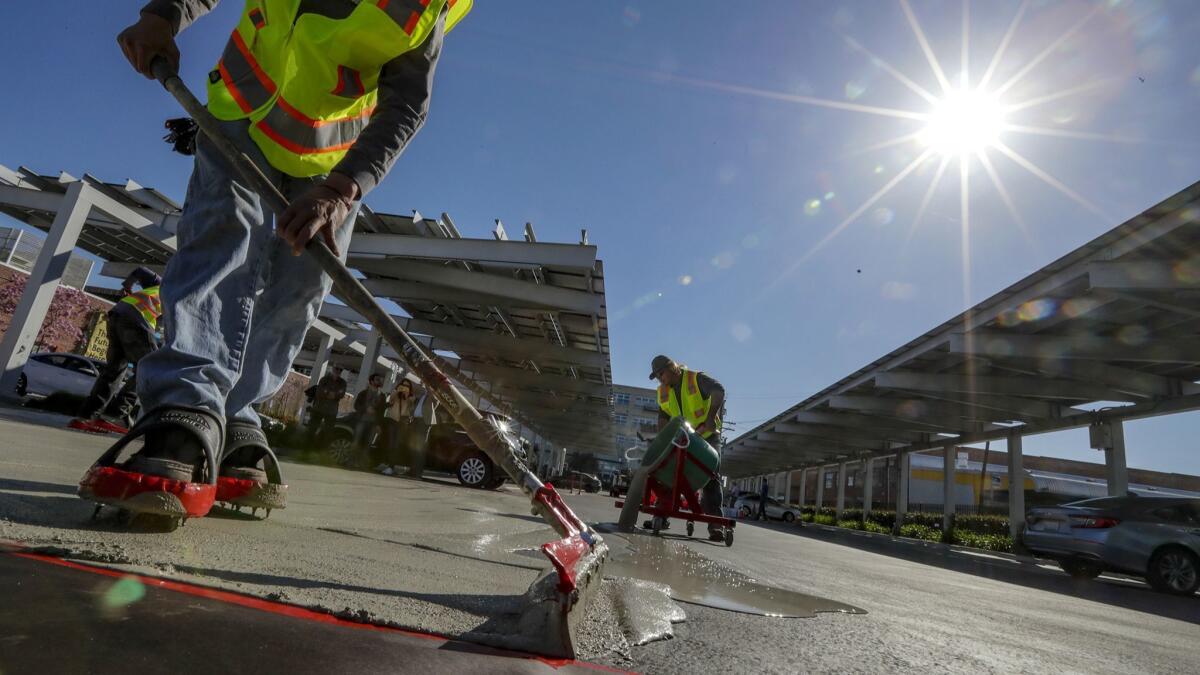L.A. takes climate change fight to the streets by pouring cooler pavement

The gray sludge poured out of giant plastic buckets like pancake batter. Workers in neon vests and spiky cleats squeegeed it across a parking lot in downtown Los Angeles, smoothing it into a thin layer beneath a cloudless sky.
This light-reflecting goop is part of L.A.’s experiment to cool the city as it’s hit by climate change.
If global greenhouse gas emissions keep rising at their current rate, temperatures in L.A. will increase nearly 4 degrees Fahrenheit by midcentury, scientists say. The metropolis is already nearly 6 degrees hotter than surrounding rural areas thanks to its masses of heat-absorbing buildings, paved surfaces and scant shade and vegetation.
Mayor Eric Garcetti has pledged to cut that difference nearly in half, reducing land surface temperatures 3 degrees by 2035. And he hopes that loads more of the viscous street-coating mixture will help.
L.A.’s mayor wants to lower the city’s temperature. These scientists are figuring out how to do it »
Once the new coating dries, the pavement outside an Arts District warehouse-turned-green-technology campus will become a putty gray that reflects more of the sun’s rays than the dark asphalt it covered up. The material — one of a handful of products the city and the Los Angeles Cleantech Incubator are testing — absorbs less heat, and thermometer readings show it can reduce surface temperatures by 10 degrees or more.
The Bureau of Street Services began spreading so-called cool pavement in the summer of 2015, starting with a parking lot at the Balboa Sports Complex in Encino. Over the last two years, crews have installed it on 15 residential blocks scattered from Northridge to Harbor City.
Now Garcetti wants to do more, starting with the installation of cool pavement on dozens of city blocks in the San Fernando Valley. His ultimate goal is to cover approximately 1,500 of the most heat-stricken blocks over the next 10 years.
“L.A. is really leading the way right now,” said Kurt Shickman, director of the nonprofit Global Cool Cities Alliance. “No one has done reflective cool pavements on this scale.”
It remains to be seen how much cooling the cool pavement can produce. Recent research has found that when manufacturing emissions are taken into account, most cool pavements hurt the climate more than they help.
Garcetti said there’s no evidence that’s the case for the cool-pavement product L.A. has been using. But he is optimistic that such issues can be resolved through innovation, saying cities must experiment to have a chance at thwarting the effects of climate change.
::
Global warming will bring more dangerous heat to Los Angeles. Within a few decades, scientists project, the number of days that top 95 degrees will double or even triple.
Extreme heat is one of climate change’s most life-threatening impacts, and it already causes more deaths in the United States each year than floods, storms and lightning combined. Climate change compounds those risks through what’s known as the “urban heat island effect,” in which the built environment of cities makes them hotter than their rural surroundings.
“Urban heat is our biggest climate challenge,” said Lauren Faber O’Connor, L.A.’s chief sustainability officer. “It’s what touches people most directly in their daily lives.”
Los Angeles County is also working to combat urban heat. A plan released this month pledged to ramp up the total land area covered by cool surfaces, starting with a 10% increase within six years.
The city’s cooling work stems from a 2015 sustainability plan that Garcetti is overhauling and renaming “L.A.’s Green New Deal.” The update, scheduled to be unveiled next week, will promise more aggressive measures to reduce greenhouse gas emissions and attack rising temperatures, including a mandate that all buildings be carbon-neutral by 2050, broader requirements for reflective “cool roofs,” and a push to plant more than 90,000 trees by 2021.
But the cool-pavement work is perhaps the most groundbreaking.
In what will be L.A.’s largest project yet, the city is preparing to install cool pavement in some of its hottest neighborhoods in the Valley. Each of the three target areas is the size of a small subdivision, covering eight to 12 city blocks that have about 30 to 40 homes each. The new coatings will be in place by June, city officials say.
“We want to see if there’s a neighborhood-level cooling effect to be achieved,” said Greg Spotts, assistant director of the city’s Bureau of Street Services.
::
To date, a handful of cities worldwide — including Athens, Tokyo and Melbourne, Australia — have tested reflective pavement coatings or lighter-colored roadways, but none have done as much as Los Angeles, Shickman said.
Yet even with the expansion, the scale of L.A.’s cool-pavement project is relatively small. The 1,500 blocks the mayor wants to convert represent only about 2% of the approximately 70,000 city blocks in Los Angeles.
The city is fighting climate change on other fronts as well, working to clean both the electric grid and its transportation system. But “the streets are where I think we can make the biggest difference,” Garcetti said.
However, there are significant doubts about whether cool pavement can produce a long-term win for the climate. A 2017 study found that most cool pavements require more energy and carbon to make than ordinary pavements, outweighing the benefits they provide by cooling the air.
“It means we have a materials challenge,” said Ronnen Levinson , who leads a group of scientists at Lawrence Berkeley National Laboratory studying ways to combat the heat-island effect. Engineers “need to find a coating that is reflective when you put it on, stays reflective and doesn’t use significantly more energy or carbon than what it’s replacing.”
Manufacturers are still developing their products. Their novelty means they are far more expensive than regular materials, at least for now.
CoolSeal, which was used at pilot sites across the city, costs $15 to $20 per gallon, said Jeff Luzar, a vice president of the Fontana-based manufacturer GuardTop. That’s more than six times as much as conventional products, “but as we produce more and more, the cost will go down,” he said.
Several other firms are moving into the market. Carlsbad, Calif.-based Petrochem Materials Innovation has developed an experimental slurry seal, a thicker material that city officials hope will not only fill cracks in deteriorating asphalt but cool it too. Crews applied the new, lighter-colored product to a Glassell Park cul-de-sac this month.
“If we can preserve streets and at the same time also provide a cooling effect, that would basically kill two birds with one stone,” said Adel Hagekhalil, who heads the city’s street services bureau.
These trials reflect the experimental nature of L.A.’s cool-pavement work. Experts are evaluating the performance of the new street coatings to ensure that they meet standards for traction and durability. They’ve noticed that oil stains and tire marks are more pronounced on the light-colored surfaces than on asphalt, which can reduce their reflectivity over time.
It’s too soon to say whether the city’s efforts will measurably cool the city. Officials are still figuring out exactly out how to gauge their progress using temperature data from NASA satellites.
USC scientists plan to use vehicle-mounted thermometers to see if they can detect a difference between neighborhoods with cool pavement and surrounding areas.
Some residents who live near the test sites have welcomed the new pavement, saying it makes their dog walks and school pick-ups more tolerable. But others confess that the difference was so slight they didn’t even notice.
Debra Lopez thinks the gray coating on the asphalt on the block outside her home on Atoll Avenue in North Hollywood is helping cool the air. Indeed, she wonders why the city hasn’t put out more.
“I have noticed a change,” Lopez said. “It feels less strong in the heat of the day. It’s not like we’re suddenly living in a cold climate, but it makes the heat easier to cope with.”
Twitter: @tonybarboza
More to Read
Sign up for Essential California
The most important California stories and recommendations in your inbox every morning.
You may occasionally receive promotional content from the Los Angeles Times.











